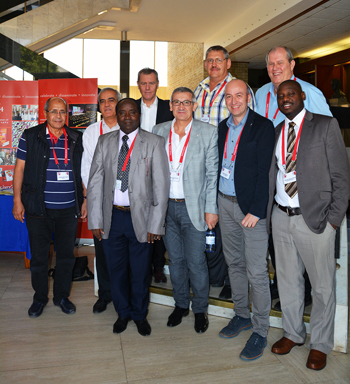What do diamonds, chocolates, bugs and almost 30 Nobel Prizes have in common? Crystallography

Some of the keynote speakers and chairpersons at the third world summit in the International Year of Crystallography (in Africa) were, from the left, front: Profs Abdelmalek Thalal (Morocco), Prosper Kanyankogote (University of Kinshasa, Democratic Republic of the Congo); Habib Bougzala (Tunisia), Santiago Garcia-Granda (IUCr, University Oviedo, Spain), Michele Zema (IYCr 2014, Italy/UK) and Dr Jean-Paul Ngome-Abiaga (UNESCO, Paris, France); back: Dr Thomas Auf der Heyde (Acting Director-general, South African Department of Science and Technology); Dr Petrie Steynberg (SASOL) and Prof André Roodt (UFS, host).
Photo: Marija Zbacnik
|
The third world summit in the International Year of Crystallography (in Africa) was hosted by Prof André Roodt, Head of the Department of Chemistry and President of the European Crystallographic Association, at the University of the Free State in Bloemfontein.
A
declaration with and appeal to support crystallography and science across Africa, was signed.
When one mentions 'Crystallography', or more simply 'crystals', what comes to mind? Diamonds? Perhaps jewellery in general? When thinking of crystals and Crystallography, you will need to think much bigger. And further – even to Mars and back.
Crystallography refers to the branch of science that is concerned with structure and properties of crystals. The obvious examples would include cut diamonds, gemstones such as amethysts, and ‘simple’ crystals such as selenite and quartz.
But have you thought about the irritating brown scales at the bottom of your kettle? The sand in your shoes? The salt over your lamb chops or the sugar in your coffee? All crystals. From egg shells to glucose, from bugs and insecticides to additives in food – even the compounds in chocolate – all fall under the close scrutiny of Crystallography.
The breakthroughs this field of science has produced have led to almost 30 Nobel Prizes over the years.
Determining the structure of DNA by crystallography was arguably one of the most significant scientific events of the 20th century. Different diseases have been cured or slowed by medicines obtained based on crystallographic studies. These include certain cancers, HIV/Aids, Tuberculosis and Malaria. Biological Crystallography enables the development of anti-viral drugs and vaccines.
This field of science influences our daily lives in virtually immeasurable ways. Here are but a few areas of study and development Crystallography contributes to:
• LCD displays;
• cellular smartphones;
• insects and insecticides;
• additives and products in foods;
• improved effectiveness and security of credit cards;
• new materials to preserve energy;
• better gasoline with less by-products;
• identify colour pigments used in paintings from the old masters, indicating if it’s an original or an imitation; and
• beauty products such as nail polish, sun-block, mascara and eye shadow.
Crystallography is also currently used by the Curiosity Rover to analyse the substances and minerals on Mars.
Crystals and Crystallography form an integrated part of our daily lives – from bones and teeth to medicines and viruses, from chocolates to the blades in airplane turbines. Even down to the humble snowflake.